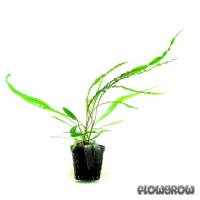



Cryptocoryne crispatula var. balansae is found in rivers and rivulets in southern Thailand, where this variety of C. crispatula forms dense, mostly submersed populations with bandlike leaves floating in the current. When the water is low, some of these plants fall dry and then form flowers. The habitats of this Cryptocoryne are often found in areas with limestone rocks, so the water is hard and rich in calcium.
C. crispatula var. balansae has been in the hobby for a long time, it is easy to cultivate and highly adaptable. It can grow to over 50 cm in height. There are different forms of var. balansae, one of the most common ones has leaves about 2 cm wide. However, leaf width can vary from 1.5 to 4 cm, and its colour may be anything between green and an attracive bronze hue.
A typical characteristic of C. crispatula var. balansae are the bullous leaves with a hammered look. The variety C. crispatula var. flaccidifolia, quite similar to C. crispulata var. balansae, differs from it by narrower (0.5 to 1.2 cm wide), unhammered submersed leaves.
In the hobby, there are several forms of this Cryptocoryne, which mostly differ regarding leaf width and colour - from green to an attractive bronze hue. This beautiful Cryptocoryne has proven to be a great aquarium plant, highly adaptable and easy to cultivate, which makes it one of the most popular Cryptocoryne species in aquaristics.
Like all varieties of the Cryptocoryne crispatula group, this plant prefers a place under medium to high light. Under sufficient light, the "hammered" knobbly pattern of the leaves develops more pronouncedly. The addition of CO2 enhances growth but is not absolutely necessary. When continually supplied with sufficient nutrients via the water or the substrate, C. crispatula var. balansae develops into a beautiful plant. It grows fastest and lushest when nutrients supply is ample, especially nitrate, phosphate and iron.
This variety prefers hard water, thus a good supply of calcium is important, too - as for most representatives of the Cryptocoryne crispatula group. A calcium deficiency results in deformed, curled leaves.
Make sure that C. crispatula var. balansae grows in stable conditions; sudden changes of the environment may result in Crypt melt (as is the case for most Cryptocoryne species).
When cultivated emersed, this Cryptocoryne does not reproduce as fast by runners as the submersed form. The flower stalks form most frequently on semi-emersed plants in shallow circulating water. Old populations growing under medium light are most likely to flower. The spathe (pseudo petal) of the flower stalk possesses a long tube. Its striking blade winds helically. The lower part of the spathe shows a pattern of purple lines and dots on off-white ground.
During the summer months, this Cryptocoryne can even be kept in an outdoor pond. It is best planted in a pot.
Old, well-established populations reproduce quickly by runners inside the substrate, which may spread far beyond the area its keeper has provided for them. Thus, a regular cutback of these runners is necessary. This is best done with a sharp knife or a razor blade. You can cut through the aquarium substrate to remove the runners (as if you were cutting the edge of a lawn), or you can just pull them out of the ground and replant them closer to the mother plant.
Since C. crispatula var. balansae can grow to a height of over 50 cm under good conditions it is best suited for the background of a tank or for very high aquaria. A well-groomed cluster of Balansa's water trumpet is a beautiful solitary eyecatcher for a Dutch aquarium. It is also a great plant for nature aquaria as it adds height and contrast to horizontally placed driftwood or rock formations. It can invoke the impression of lush growth, and fish swimming through the leaves of this plant like through reeds are a highly attractive sight.
<a href="https://www.flowgrow.de/db/aquaticplants/cryptocoryne-crispatula-var-balansae" target="_blank"><img alt="Cryptocoryne crispatula var. balansae" title="Cryptocoryne crispatula var. balansae" src="https://www.flowgrow.de/db/widget/aquaticplants/cryptocoryne-crispatula-var-balansae" /></a>
[url=https://www.flowgrow.de/db/aquaticplants/cryptocoryne-crispatula-var-balansae][img]https://www.flowgrow.de/db/widget/aquaticplants/cryptocoryne-crispatula-var-balansae[/img][/url]
[widget=aquaticplants/cryptocoryne-crispatula-var-balansae]Cryptocoryne crispatula var. balansae[/widget]